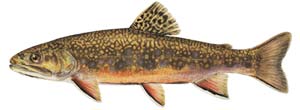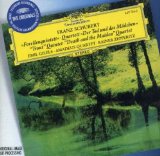The Trout Quintet
A Cheerful Countryside Work
Schubert's Trout Quintet is a light and lively chamber piece, which recycles one of the composer's most popular melodies...
Schubert wrote it for a keen patron, who wanted the composer to include the popular melody from his song "The Trout".
Origins of the Quintet
In 1819, Schubert was touring the Austrian countryside on a kind of holiday. He met an enthusiastic amateur cello player called Sylvester Paumgartner, who also happened to be a wealthy mine owner.
Paumgartner was extremely fond of Schubert's song "The Trout", a jolly little tune about fishing. He asked the composer to write a string quintet using the melody from the song.
People think he asked for a quintet specifically so that his cello part would be more fun to play, instead of just plodding out the bass to support the melody in the other instruments (like in a regular string quartet).

Schubert was eager to please (and perhaps in need of some patronage?), so he recycled his old song and sent Paumgartner the brand new Trout Quintet.
But although Paumgartner was a really keen cello player, he wasn't a very good one! Schubert had accidentally made the cello part a bit too difficult for the poor patron, who struggled to perform it properly. Oh dear!
Paumgartner got a group of musicians he had already hired to play it in his house, but the composer shelved the score after that. It was never performed publicly in Schubert's lifetime. It was only published a year after Schubert died.
Schubert is actually more famous for his 600+ songs, which he wrote all throughout his life...
The Lively Music
The Trout Quintet has a bit a of a weird instrumentation setup. The normal layout of a string quintet is basically just a string quartet (two violins, one viola, one cello) with a piano stuck on.
But the Trout Quintet has one violin, a viola, a cello, a piano, and a double bass as well. Highly odd! I suppose the double bass adds some balance to the high tinkling piano passages.
The quintet is a very light and melodic piece, with not much drama or sadness. It's fun to listen to, but there's not very much to sink your teeth into!
I think that the piece's bright sound is because Schubert was feeling cheerful and refreshed after his trip to the country. That, or he didn't want to upset his patron Paumgartner with too much drama!
The 4th movement is where all the variations from the song are. Schubert basically passes the melody around all the instruments, slows it down, speeds it up, and generally plays around with it.
The fun piano accompaniment part from the song isn't played until really close to the end. Maybe Schubert was teasing Paumgartner? I have an image of the patron on the edge of his seat, waiting for the piano part to come, and getting excited when it finally arrives...
The quintet is in A Major, and is in 5 movements:
- Allegro Vivace (fast and lively)
- Andante (walking pace)
- Scherzo: presto (quick)
- Andantino (theme and variations)
- Allegro giusto (quick, strict)
Schubert was also a bit creative in his harmonies. He basically used non-traditional harmonic techniques, which create a more relaxed and carefree sound. I reckon this is the influence of his holiday again!
Here are some of my favorite variations from the 4th movement. First though, here's the original song:
Ahhh, wonderful!
And now my favorite variations...
My favorite movement is definitely the 5th movement though. I find the melodies really catchy. It's a perfect finish to this fun quintet!
Good Recordings
One recording I like is by the Amadeus Quartet. They manage to keep the piece sounding happy and light, while balancing everything exquisitely. Bravo!
There's a really fascinating documentary about a group of famous musicians who rehearse and perform the Trout Quintet. It's a great insight into how performers go about learning and interpreting the piece. You can watch the first part here.
You might also like Schubert's beautiful piano Impromptus
If you like my site, please click "Like"... thanks!



